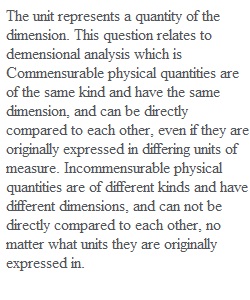


Q This assignment aligns with the following Unit Objectives: • (U08) Convert from one unit system to another. (CLO2)(CLO5) • (U09) Use dimensional analysis to check the consistency of your work. (CLO5) • (UDS) Develop a well thought out and correct response to various discussion questions (CLO2)(CLO3)(CLO5)(Goal 4) Do not start a new thread. Simply reply to my posting. Be sure to comment on at least two of your classmates' postings. Your replies must be more than a simple phrase like "I agree" or "I like your answers". Replies should reflect why you agree or like what has been posted. Your replies must reflect a genuine effort to engage your fellow classmates regarding the comments provided or the problem that has been solved. Please post your answers and replies to the discussion questions below 1. You can always add two numbers that have the same units. However, you cannot always add two numbers that have the same property. Explain why not, and include an example in your explanation. 2. Considering the fact that 3.28 ft = 1 meter, which is the larger unit? Explain your answer. 3. How many liters are in a gallon? 1 L = 1.057 qt. Show all of the steps! 4. What is the purpose of showing your units throughout a calculation instead of just attaching them to the numerical answer at the end?
View Related Questions